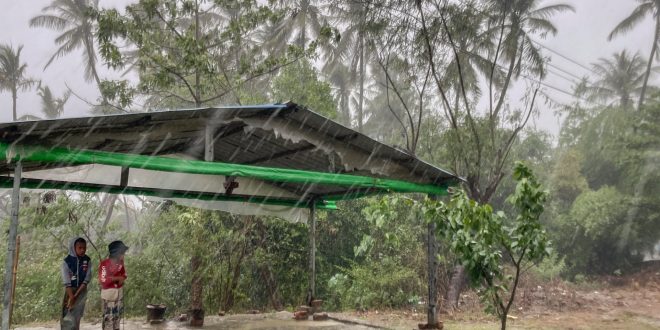Thousands of people have hunkered down in monasteries, pagodas and schools, seeking shelter from a powerful storm that slammed into the coast of Myanmar and southeastern Bangladesh on Sunday.
As Cyclone Mocha crashed ashore, it uprooted trees, scattered flimsy homes in Rohingya displacement camps in Bangladesh, and brought a storm surge into low-lying areas.
Rescue services in Myanmar said two people were killed in a landslide, while local media reported the death of a man in Myanmar after a tree fell on him.
Packing winds of up to 195km/h (120mph), Mocha hit between Cox’s Bazar, home to nearly one million Rohingya refugees in Bangladesh, and Myanmar’s Sittwe, according to Bangladesh’s weather office.
Streets in Sittwe were turned into rivers as the biggest storm to hit the Bay of Bengal in more than a decade surged through the seaside town.
Al Jazeera’s Tanvir Chowdhury said the main Rohingya refugee camp in Cox’s Bazar had been spared from the central thrust of the cyclone. The wind speed was high, with “more of a drizzle than torrential rain”, Chowdhury said.
He said that while assessment of the damage was under way, it would take time to ascertain.
“It will take days and weeks to confirm the real damage [from the cyclone] as there are several small scattered coastal islands where fishermen don’t have means to communicate and don’t pay heed to warnings,” Chowdhury reported from Cox’s Bazar.
Myanmar’s military information office said the cyclone had damaged houses, electrical transformers, mobile phone towers, boats and lampposts in Sittwe, Kyaukpyu and Gwa townships. It said the storm also tore roofs off of sport buildings on the Coco Islands, about 425km (264 miles) southwest of the country’s largest city, Yangon.
A rescue team from the country’s eastern Shan state announced on its Facebook page that they had recovered the bodies of a couple who were buried when a landslide caused by heavy rain hit their house in Tachileik township.
Local media reported that a man was crushed to death when a banyan tree fell on him in Pyin Oo Lwin township in the central Mandalay Region of Myanmar.
In Sittwe, a cell phone tower collapsed amid strong winds and other buildings were damaged, local media reported.
More than 4,000 of Sittwe’s 300,000 residents were evacuated to other cities and more than 20,000 people are sheltering in sturdy buildings such as monasteries, pagodas and schools located on the city’s highlands, said Tin Nyein Oo, who is volunteering in shelters in Sittwe.
Many local people live in elevated areas more than 3m (10 feet) above sea level, where residents believe the storm surge cannot reach, he added.
Titon Mitra, the United Nations Development Programme representative in Myanmar, tweeted: “Mocha has made landfall. 2m people at risk. Damage and losses are expected to be extensive. We are ready to respond and will need unhindered access to all affected communities.”
Mocha has made landfall. 2m people at risk. Damage and losses are expected to be extensive. We are ready to respond and will need unhindered access to all affected communities. #whatsHappeningInMyanmar @UNDPasiapac @UNDP pic.twitter.com/GPaC1BQSwQ
— titon (@TitonMitra) May 14, 2023
Authorities in Cox’s Bazar, which lay in the storm’s predicted path, said earlier that they had evacuated some 1.27 million people, but by early afternoon it appeared that the storm would mostly miss the country as it veered east, said Azizur Rahman, director of the Bangladesh Meteorological Department in Dhaka.
“The level of risk has reduced to a great extent in Bangladesh,” he told reporters.
Strong winds accompanied by rains continued on Saint Martin’s Island in the Bay of Bengal in the afternoon, but feared tidal surges did not take place because the cyclone started crossing the Bangladesh coast at low tide.
Communication networks in Rakhine had been disrupted after the cyclone made landfall, the UN and local media said.
“For a cyclone to hit an area where there is already such deep humanitarian need is a nightmare scenario, impacting hundreds of thousands of vulnerable people whose coping capacity has been severely eroded by successive crises,” UN resident coordinator Ramanathan Balakrishnan said.
Roxy Mathew Koll, a climate scientist at the Indian Institute of Tropical Meteorology in Pune, India, said cyclones in the Bay of Bengal are becoming more intense more quickly, in part because of climate change.
Al Jazeera’s Chowdhury said Bangladesh’s cyclone warning systems were “some of the best among developing countries” and have helped save lives in recent years.
“People are always days ahead about possible dangers of the cyclone with the help of warnings, volunteers and mobile apps,” he said, adding that while property, crops and livestock could suffer damage, “lives are saved”.

‘We are scared’
The wind ripped apart homes made of tarpaulin and bamboo at one camp for displaced Rohingya at Kyaukphyu in Myanmar’s Rakhine state.
Its residents were anxiously watching the rising sea tide, camp leader Khin Shwe told AFP.
“We are now going to check whether sea water is increasing to our place… if the sea water rises, our camp can be flooded,” Khin Shwe said.
In Teknaf in Bangladesh, high winds uprooted trees, brought traffic to a halt and sent residents running for cover, an AFP correspondent said.
“Our camp houses, which are constructed with bamboo and tarpaulins, can be blown away in soft, light winds,” Mohammad Sayed, 28, told AFP from Nayapara refugee camp in Cox’s Bazar.
“The schools, which are designated as cyclone shelters … are not strong shelters that can withstand the winds of a cyclone. We are scared.”
Thousands left Sittwe on Saturday, packing into trucks, cars and tuk-tuks and heading for higher ground inland as meteorologists warned of a storm surge of up to 3.5m (11 feet).
“We are not OK because we didn’t bring food and other things to cook,” said Maung Win, 57, who spent the night in a shelter in Kyauktaw town further inland. “We can only wait to get food from people’s donations.”
Cyclone MOCAH wind waves are going into stronger than previous.
Please pray for Rohingya Refugees. pic.twitter.com/ufljmUSS9j
— Azimul Hasson (@azimulhass) May 14, 2023
Bangladeshi authorities had moved 190,000 people in Cox’s Bazar and nearly 100,000 in Chittagong to safety, divisional commissioner Aminur Rahman told AFP late Saturday.
The Myanmar Red Cross Society said it was “preparing for a major emergency response”.
In Bangladesh, authorities have banned Rohingya refugees from constructing concrete homes, fearing it may encourage them to settle permanently rather than return to Myanmar, which they fled five years ago following a brutal military crackdown.
The camps are generally slightly inland but most of them are built on hillsides, exposing them to the threat of landslides.
Forecasters expect the cyclone to bring a deluge of rain, which can trigger landslips.
Severe weather strikes Camp 26 in Teknaf, one of the southernmost #Rohingya camps, causing significant damage to shelters and displacing many residents. Video by Saiful Arakani.
Cyclone 🌀 Mocha #Bangladesh pic.twitter.com/Q7VRqgDrwi
— Shafiur Rahman (@shafiur) May 14, 2023
“The wind started about 8:30 this morning and it’s getting stronger,” a Rohingya community leader in the Kyaukphyu displacement camp told AFP.
“A house at the camp collapsed and the roof of a shelter built by UNHCR [the UN High Commissioner for Refugees] was blown away,” they said, requesting anonymity.
Hundreds of people also fled Bangladesh’s Saint Martin’s Island, a local resort area right in the storm’s path, with thousands more moving to cyclone shelters on the coral outcrop.
Those left behind said they feared the storm’s approach.
“We are in a panic because we don’t have enough cyclone shelters here,” Saint Martin’s resident Jahangir Sarwar, 23, told AFP by phone.
“We asked the administrators many times that everyone should be evacuated to a safe place in mainland Teknaf town. But no action was taken.”
 Top Naija News: Nigerian News, Breaking News Nigeria and World News Top Naija News is a daily news publication in Nigeria, delivering the latest breaking news in Nigeria and around the world.
Top Naija News: Nigerian News, Breaking News Nigeria and World News Top Naija News is a daily news publication in Nigeria, delivering the latest breaking news in Nigeria and around the world.




